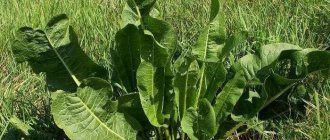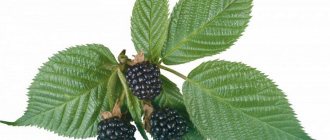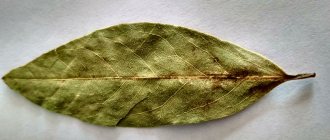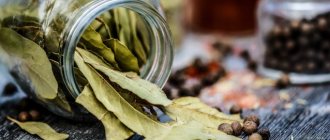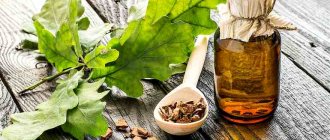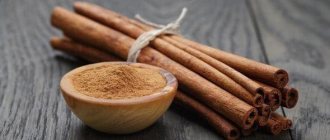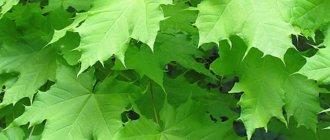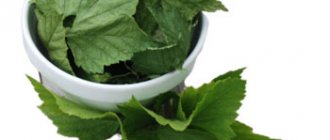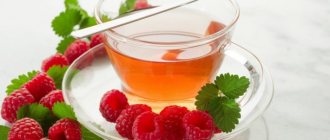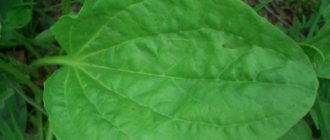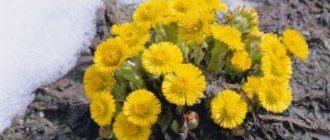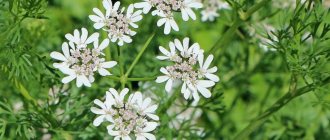What are the benefits of horseradish leaves?
The composition of the greens of this plant includes phytoncides. These substances have an antimicrobial effect, which persists even in dried leaves.
The culture is used as an aid for many health problems:
- removes salts, toxins and heavy metals from tissues;
- eliminates joint pain and promotes the restoration of cartilage tissue;
- fresh leaves improve appetite and stimulate digestion;
- infusions and decoctions have a beneficial effect on the respiratory system - they are used in the treatment of cough, sore throat and sinusitis;
- Regular consumption of dishes with this plant helps normalize cholesterol levels in the blood and serves as a prevention of atherosclerosis;
- fresh leaves are used as compresses for severe headaches;
- crushed greens are used in cosmetology to nourish and rejuvenate the skin and stimulate hair growth.
Composition and properties
The benefits of horseradish leaves for the body are explained by their rich chemical composition.
Reference! Greens contain almost all the vitamins and minerals needed by the human body.
100 g contains:
- 9.4 g protein;
- 1.4 g fat;
- 6.2 g carbohydrates.
The composition of greens includes the following vitamins and minerals (per 100 g):
- vitamin PP – 4.6 mg;
- vitamin B9 (folic acid) – 40 mcg;
- vitamin B6 (pyridoxine) – 1.2 mg;
- vitamin B5 (pantothenic acid) – 0.13 mg;
- vitamin B2 (riboflavin) – 0.66 mg;
- vitamin B1 (thiamine) – 0.26 mg;
- vitamin C (ascorbic acid) – 51.7 mg;
- potassium – 337 mg;
- calcium – 185 mg;
- magnesium – 147 mg;
- phosphorus – 112 mg;
- sodium – 9 mg;
- iron – 4 mg;
- manganese – 1.06 mg;
- zinc – 0.6 mg;
- copper – 0.11 mcg;
- selenium – 0.9 mcg.
Not only fresh and dried leaves, but also horseradish roots have beneficial properties. Juice is pressed from fresh raw materials. It is used to improve appetite and the functioning of the digestive system. Fresh leaves also have an analgesic and anti-inflammatory effect, so they are often used in the treatment of radiculitis.
The dried raw materials are ground into powder and infusions are prepared on its basis for the treatment of rheumatism and throat diseases.
Useful properties of horseradish
This plant is called Russian wasabi, and for many people its properties can be a revelation. Indeed, its fiery taste is very similar to Asian spice. It is in those ingredients that determine this unique burning taste that the healing secret of horseradish lies. The composition of leaves and roots is very rich:
- Essential oils. When used topically, essential oils promote faster penetration through the pores into the skin and further into the structures and tissues of the joint.
- Vitamins. There are a lot of them here, especially vitamin C, which is what is so necessary for the synthesis of collagen - an integral part of connective tissue and cartilage. In addition, vitamin C strengthens the vascular wall, which means blood flow to the joints improves. There are also a lot of B vitamins here, which help the normal functioning of the nervous system and muscles. Vitamin E is a natural antioxidant and helps prevent disorders of all organs and systems.
- Microelements. Poor nutrition is one of the reasons for decreased immunity and, as a consequence, the development of many diseases, including the musculoskeletal system. For this purpose, horseradish is useful to take orally. Potassium, manganese, magnesium, iron, zinc - this list of minerals in horseradish is far from complete.
- Phytoncides. These are unique biologically active components that act as local antiseptics, which means they play a significant role in prevention.
There are polyunsaturated fatty acids, natural sugars, and fiber. But what effect does the composition of horseradish have on the body, in particular on the human skeleton? Its impact is multifaceted:
- Antivirus. Many inflammatory diseases begin with the penetration of viruses and bacteria into various tissues. The antiviral effect of horseradish neutralizes this process.
- Antiseptic. This action helps in local disinfection. Horseradish is especially good to use topically for this purpose.
- Blood thinner. Horseradish not only thins the blood, but also accelerates the microcirculation of all fluids in this area.
- Decongestant. This action follows from the previous one. Since horseradish components accelerate blood circulation, swelling at the site of its application quickly subsides.
- Warming up. Due to the acceleration of blood flow, a person feels a surge of heat to the place where horseradish is applied. Thanks to this natural and natural heating, joint mobility improves.
Horseradish can treat the following joint diseases:
- rheumatism,
- arthritis,
- radiculitis,
- arthrosis,
- osteochondrosis,
- gout.
In the summer, prepare a compress from fresh horseradish leaves. Pre-scalding helps to activate the movement of juice in the leaf
In the early stages of joint deformation, this vegetable is simply irreplaceable, but even advanced arthrosis can be healed. With targeted use, the patient will definitely see positive results in the form of stopping the pathological deforming process, removing swelling, significantly reducing pain or completely getting rid of it.
Therapeutic effect
The healing properties of horseradish leaves are primarily expressed in their ability to prevent the deposition of salts. Regular use of alcohol tincture helps to avoid joint pain.
The plant is also useful for eating. Once in the stomach, horseradish stimulates the production of enzymes and gastric juice. This improves appetite and normalizes the functioning of the digestive system.
In addition, the culture is considered a natural antibiotic. The substances included in its composition destroy bacteria and fungi, so horseradish root and leaves are added to winter preparations to extend shelf life.
What diseases does it help with?
Fresh horseradish leaves, as well as infusions, decoctions and compresses based on them, help against many diseases:
- reduce cholesterol levels in atherosclerosis;
- prevent salt deposition in osteochondrosis and destruction of cartilage tissue in osteoporosis;
- have an anti-inflammatory effect;
- used in the treatment of hepatitis;
- when taken orally, they effectively relieve headaches, and as compresses – pain in the cervical, thoracic and lumbar spine;
- used to gargle for sore throat, to treat sinusitis and cough.
How are they used in cooking?
The rich, pungent taste of horseradish has found application in cooking. Fresh leaves and roots are often used in canning and pickling. Sauces are also prepared from root vegetables and added to salads and vegetables for pickling.
In Russian cuisine, “khrenoder” (“horseradish”) is a traditional addition to fried meat and jelly. Young leaves are added to soups and salads. Ground dried herbs are used as a seasoning for meat, poultry and vegetable dishes.
Use of horseradish leaves in cooking
Unlike modern man, ancient people knew how to rationally manage natural resources. They found a use for every blade of grass, every fruit. Since those time immemorial, horseradish has been used as an aromatic additive to a huge number of dishes. As for the green part of the plant, it was mainly used for preservation.
In modern cooking, horseradish leaves can be used in the following cases:
- as a main ingredient for salads;
- for decorating sandwiches;
- as a seasoning for soups and meat dishes;
- for marinades.
Spicy herbs go well with fish, and jellied meat is impossible to imagine without such an additive.
Among gourmets, there are many who like to consume fresh leaves in a “live” form, that is, chew, which, of course, is very beneficial for the health of teeth and the entire body as a whole.
An interesting combination of horseradish leaves with cabbage and seaweed.
We offer you to replenish your home repertoire of delicious recipes with a vitamin salad that can be prepared in a hurry:
Ingredients:
- horseradish leaves – 50 g;
- cucumber – 2 pieces;
- sour cream – 2 l. Art.;
- green onions - a small bunch;
- parsley and dill;
- salt - to taste.
Preparation:
- Young horseradish greens, like all other greens, must be finely chopped.
- Cucumbers are cut into thin slices.
- Then all the parts are combined, the dish is salted and seasoned with sour cream.
This simple dish will saturate the body with vitamins and help you lose excess weight.
Use in folk medicine
In folk medicine, several uses of this vegetable are practiced. Tinctures and rubs are prepared from it, and young leaves are used for compresses.
Compress
Herbal lotions are used to relieve joint pain:
- Fresh leaves are ground into a paste, mixed with a tablespoon of lemon juice and rubbed into the sore joint several times a day.
- To relieve inflammation, young leaves are applied to the sore joint and left overnight.
- A compress of horseradish leaves and apples, minced and mixed in equal proportions, will help relieve pain and reduce inflammation.
This is interesting:
Step-by-step instructions for planting horseradish in the fall for beginner gardeners
What varieties of horseradish are there and how to choose the best
Rubbing
Rubs based on horseradish leaves are used to treat knee arthrosis. Application options:
- The chopped greens are poured with hot water and brought to a boil.
- Moisten gauze in the cooled liquid, place a young horseradish leaf on it and apply it to the sore joint.
- In winter, dry leaves are used to prepare the rub. For 600 ml of water you will need 25 g of raw materials.
- Rubbing from horseradish greens, turnips and radishes relieves inflammation well. The components are taken in equal proportions and crushed in a blender. The resulting pulp is gently rubbed into the sore joint.
Tincture
Tincture of horseradish leaves is a universal medicine. It is used externally for rubbing, and internally to eliminate inflammatory processes in the throat and digestive organs.
The medicine is prepared as follows:
- 5-6 large horseradish leaves are crushed, placed in a jar and filled with 500 ml of vodka or alcohol.
- Cover the container with a lid and leave in the refrigerator for a week.
- Before use, strain and drink a tablespoon three times a day 30 minutes before meals.
If you add a little honey or lemon juice to the tincture, it will serve as an effective remedy in the fight against colds and coughs.
Treatment with horseradish leaves: the versatility of the properties of this greenery
Horseradish foliage in folk medicine is considered a universal medicine. Experienced herbalists know how to prepare a wide variety of potions from this amazing plant.
They share their secrets so that everyone can use their recipes to prepare their own ointments and tinctures. Herbalist recipes help the common man to prepare the right medicine.
First of all, it is noted that only young leaves can be used for treatment, even before the root matures. Young greens contain many useful substances that are lost when the root gains strength.
Tincture of horseradish leaves with vodka
Method of preparation: wash freshly cut leaves, dry, finely chop. It is better to prepare the tincture in enamel or glass containers.
Tincture components: crushed leaves and vodka are taken in equal quantities. Place the chopped greens in a bowl and pour in an equal amount of vodka or pure moonshine.
The dishes should be covered tightly and placed in a dark, cool place for a week, or in the refrigerator. Stir the contents of the dish several times during the week.
After a week, strain the tincture and store the strained product closed in the refrigerator. You can drink 30 g of tincture ½ hour before meals. The product has a significant warming effect, this should be taken into account when using it.
Tincture not vodka
Compress with leaves
Method of preparation: select a young fresh leaf, rinse it, dip in boiling water for 30 seconds. Dry and apply warm to the place of pain, for example, on the knee joint, or on the back, on the cervical spine.
It is important to consider which side to apply the horseradish leaf - only its outer side.
Cover the sheet with cling film and keep the person warm. The compress relieves pain; it should be applied at night to get the best effect. In the morning, when the compress is removed, under it you can find salt that has come out overnight.
This is due to the fact that essential oils draw out salt. The area under the compress should be lightly washed with water and spread with cream. It is recommended to apply the compress every other day, no more than 3 times a week.
Horseradish leaf compress
Horseradish leaf ointment
Method of preparation: wash the leaves, dry them, chop finely. Place the resulting mass in a glass container, pour in vegetable oil so that it covers all the greens.
Cover the jar with a lid and place in a dark place for a week. During this time, it is recommended to turn the jar over several times to mix its contents. After 7 days, mix the mixture and strain off the greens.
The result is a ready-made ointment that can be used to rub any sore spot. The ointment begins to act immediately after rubbing due to the high content of essential components. This is an effective method of treating osteochondrosis in the acute stage, with pain in the joints and back.
You can use the resulting potion 2 times a day; it is recommended to wrap the ground area warmly. The use of the ointment is designed to ensure that the person is not allergic to the components of the product.
Horseradish ointment
Baths with horseradish leaves
Method of preparation: wash the leaves, dry them, pour boiling water in a ratio of 1 liter per 1 leaf. Cover the dishes and place in a dark place for 3 days. After this, pour the infusion into a bath with warm water, you can take a bath together with the leaves 2 times a week.
Then take a break for 2 months and repeat the course of treatment. Such baths remove salts and improve the functions of the circulatory system. In such a bath, tense muscles relax, and pain from such tension is relieved.
Compress of horseradish leaves and apple
Method of preparation: chop the leaves and green apples to obtain an equal mass of ingredients. Place the resulting mixture on a cotton cloth, apply it to the sore spot, and insulate it with blankets.
This is an effective method of relieving pain caused by heel spurs. Keep the compress until it dries naturally.
Then remove it, rinse with water, lubricate with emollient cream to avoid dry skin and possible irritation.
Herbalists note that in any treatment, only horseradish leaves should be used, the root is not used. When using the roots, a sharp expression of allergies is possible. When using the recommended products, you must strictly follow the instructions for use so as not to get burned from the strong essential oils of the plant.
Use in cosmetology for skin
In cosmetology, horseradish leaves are used to eliminate skin problems. They are used to prepare therapeutic and prophylactic masks.
Note! To whiten the skin and eliminate age spots, a decoction of horseradish root is mixed with juice from fresh leaves in equal proportions. The resulting pulp is diluted in half with boiled water and wiped on the face twice a day.
Mask recipes:
- To tighten pores and eliminate dull skin: 1 tsp. The pulp from the leaves is mixed with 2 tsp. grated apple Add 1 tsp. honey and apply the mixture to your face for 10 minutes.
- To treat acne: after washing with warm water, apply a paste of leaves to the face and leave for 10-15 minutes. If a burning sensation occurs, wash off the mask earlier.
- For rejuvenation: horseradish root is passed through a meat grinder, two leaves are crushed in a blender and 1 tbsp is added. l. sour cream. The paste is applied to the face in a thin layer and left for 15 minutes. Wash off with a cotton pad soaked in warm milk, and after 5 minutes wash with warm water.
For hair
The rich chemical composition of horseradish leaves has a beneficial effect on the condition of hair. To strengthen hair follicles and prevent hair loss, prepare the following mask:
- A tablespoon of fresh juice from the leaves is mixed with 1 tsp. castor and 0.5 tsp. burdock oil.
- The liquid is mixed, add 1 tbsp. l. corn starch and 1 tsp. cognac
- The resulting mixture is applied to the roots of clean hair, covered with film, wrapped in a towel and left for an hour, after which it is washed off with shampoo.
This mask increases blood flow to the hair follicles, stimulates their growth and eliminates dandruff.
This is interesting:
What are the benefits of sauerkraut juice for the face and how to prepare various masks with it?
The best potato face masks
For weight loss
Horseradish leaves contain the enzyme myrosin. They activate metabolism and reduce fat accumulation.
Slimming balm is prepared from 100 g of crushed root mixed with 3 tbsp. l. honey and juice of half a lemon. All ingredients are mixed and taken twice a day, a teaspoon before meals. The product is stored in a container with an airtight lid for no more than three days.
Useful and medicinal properties of horseradish leaves
Experts note that horseradish roots and leaves have numerous beneficial properties. Among them are the following:
- Antiseptic and bactericidal properties help fight inflammatory processes in the oral mucosa.
- You can use them to cleanse the body of toxins and waste.
- They increase appetite and activate the production of gastric juice and enzymes. Useful for metabolism and normalization of the gastrointestinal tract.
- The leaves are used to treat inflammatory processes in the respiratory tract.
- The medicinal properties of the leaves have shown themselves to be effective in eliminating osteochondrosis, arthritis, radiculitis, they relieve pain and eliminate inflammation.
- The restorative effect is used in the treatment of influenza and acute respiratory infections. Due to the carotene content, the leaves act as an antioxidant, preventing the action of various infections.
- The diuretic property is used in the treatment of cystitis, gout and dropsy.
- The leaves have a tonic effect for heart diseases, atherosclerosis and anemia.
- Helps fight insomnia and headaches. Fresh leaves are lightly kneaded with your hands until the aroma appears and applied to your temples.
the rich chemical composition of horseradish leaves allows for a therapeutic effect on human health
Beneficial properties for the body of women and men
Many people who like to take steam baths, knowing the benefits of horseradish leaf, add it to the water for aromatization. When heated, the beneficial components of the plant are activated, which helps eliminate toxins and improve the condition of the entire body in both men and women.
In addition, men can use an alcohol tincture of the green part of horseradish to increase potency. The product is used 1 tbsp. l. 3 times a day before meals. To improve the taste, add nutmeg, cloves or cinnamon to the tincture. This plant is considered a natural aphrodisiac that improves sexual function.
Often, as a result of sedentary work, the sciatic nerve suffers in men and women; a compress of leaves will help cope with the inflammatory process and lower back pain.
It is useful for women to add the green mass of the plant to various dishes; it improves digestion, speeds up metabolism and promotes weight loss. And cosmetic masks improve the condition of the skin and help fight age spots.
